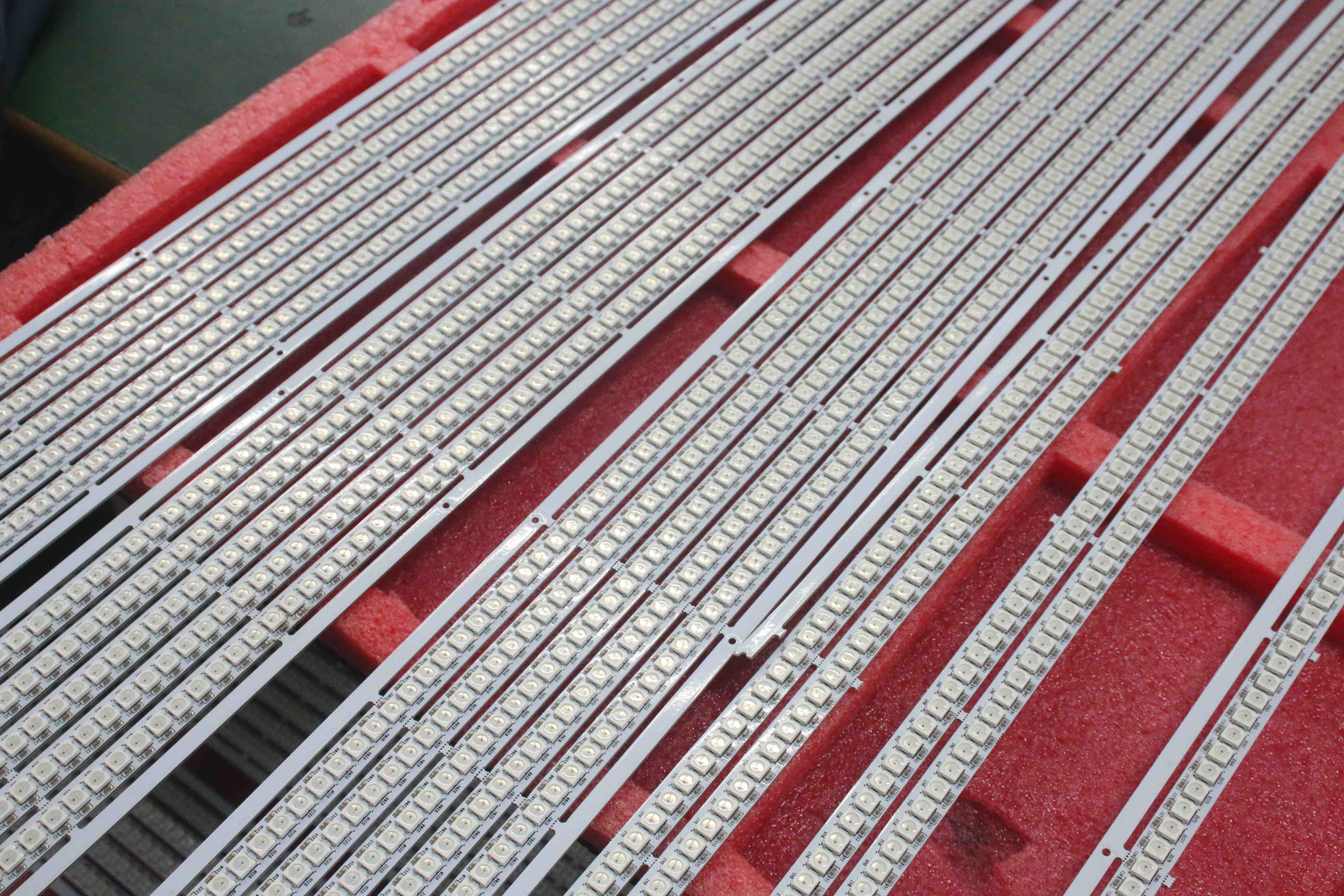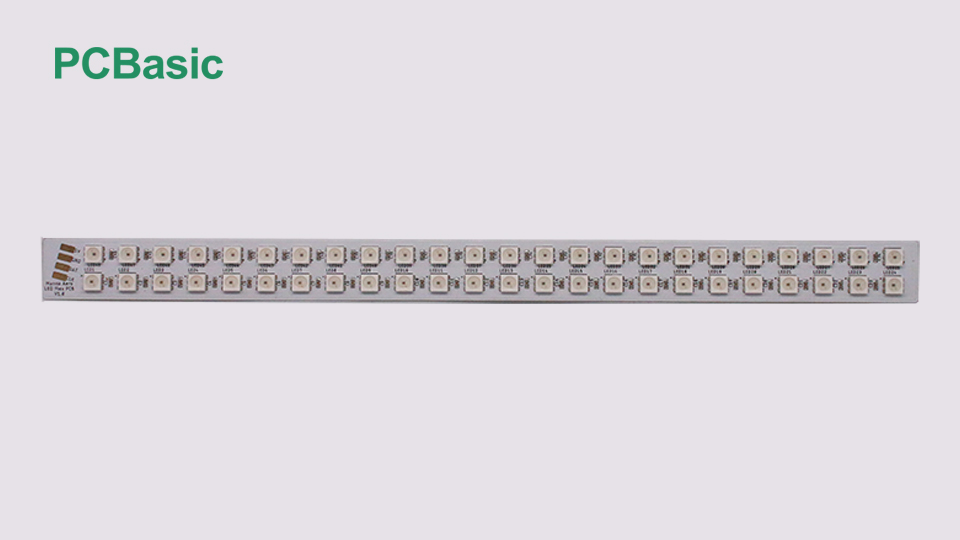Due to the unique features of LED lights, they are becoming popular in both residential and industrial applications. Nowadays, LED lighting has become the top choice for various industries, such as automotive, medical, transportation, and consumer electronics/smart devices. LED PCB is a thin board made of metal, fiberglass, or any other material that electrically connects light-emitting diodes (LEDs).
With the advancement of technology, the LED PCB manufacturing process is a lot easier and more reliable compared to the old days. This article will explore everything about LED PCB boards, their types, industry trending benefits and features, applications, and a brief analysis of the LED lighting industry. You can use this guide to learn about the facts to be considered when designing LED light circuit boards. At the end of the article, you will find how you can get expert support for your next LED PCB project.
What is LED PCB?

LEDs stand for light-emitting diodes. Those diodes are solid-state semiconductors that turn electric current and voltage into light. An LED PCB, short for Light Emitting Diode Printed Circuit Board, is a type of PCB specifically designed for LED technology.LED circuit boards are good at creating and dissipating large amounts of heat. An LED PCB consists of an aluminum base coat that performs heat management, a dielectric layer, a copper circuit layer, and a solder mask.
You might be wondering, What is so unique in LED technology? The answer would be a highly efficient and compact design. The LEDs can fit in PCB designs with different shapes and forms.
Back then, traditional light bulbs were designed in a very particular way. They were power-hungry and expensive to produce. The semiconductor diode emitters, however, can fit in any PCB design. They enable companies to create many applications for hundreds of different industries. The led materials mainly consist of silicon, similar to many other products based on semiconducting materials.
LED PCB comes in many variations and designs. Each one has its pros and cons. Different LED PCB design techniques shall be applied according to each company and product needs.
LED PCB Structure and Materials
LED PCB board structures change based on the application and requirements. The central concept of PCB manufacturing stays the same. Here are some of the materials used in custom LED PCB designs:
FR-4
FR-4 is one of the most common materials used in PCB production. It consists of glass, epoxy, and copper. The material is simple and cheap to produce and does an excellent job regarding industrial applications and heat resistance. However, this material has a disadvantage in heat dispensing efficiency. Heat dispensing should always be the priority during the LED PCB design process.
Aluminum PCB
Aluminum LED PCB often consists of aluminum and other types of metals. This kind of material is precious when it comes to efficient heat dissipation and insulation of electrical circuits. Aluminum PCB for LEDs is very common and considered the first choice when producing your LED circuit board.
Epoxy PCB
Epoxy is a material often used in PCB production but isn't very common for LED PCB board designs. The reason is that epoxy is fragile. Other options, such as FR-4 and aluminum PCB, are often recommended for LED PCB fabrication.
Because of the vital role of heat transfer in LED PCB applications, metals, especially aluminum, are the most common LED PCB materials. Aluminum's low-cost and efficient PCB manufacturing process results in great manufactured products. Most manufacturers will recommend it for LED-related productions depending on the application's needs.
Types of LED PCB Boards (Aluminum)
While the layer consistency of aluminum LED PCB stays the same, there are multiple options when it comes to the PCB type and its flexibility:
Single-Layer LED Circuit Board
Normally, less power applications use single-layer LED lighting boards due to their simplest structure. It contains a single layer with better conductive materials like copper, with the other side surface-mounted electronic components. Besides its simplest design, it provides an affordable and versatile LED PCB solution for your application.
Flex Aluminum LED PCB
As with any other PCB, flex PCB is always a great option. This type of LED PCB is often used in applications that might need some "bending" due to tight space or particular environment needs. The flex aluminum PCB persists in its excellent insulation with added flexibility by design. Modern smart devices and applications like wearable devices use flex LED PCBs. LED strips are the best example of a flexible LED circuit board that provides upgraded portability and functionalities.
However, this is the most expensive PCB type compared to other LED PCB boards. Another significant disadvantage of the flex board is the complexity of replacing damaged components. Flex PCBs are more fragile than rigid PCBs, which might be a problem in specific applications that often move or are exposed to harsh environmental conditions.
Hybrid LED PCB with Aluminum
This type of PCB combines a rigid FR-4 PCB and an aluminum design. Combining both types can increase the PCB's durability and heat dissipation abilities. Hybrid PCBs come at a low and affordable cost, allowing LED designs to be manufactured and mass-produced with ease.
Multilayer LED PCB
When it comes to multilayer PCB designs, aluminum material plays a crucial role. The board would provide efficient conductivity and performance if the multilayer LED PCB design had over two layers. However, an essential part is its excellent heat dissipation ability. Multilayer PCBs are the most common types, as they provide complex circuits with the necessary flexibility and capability.
The type of aluminum board used by the LED PCB design will likely depend on the project application needs. The critical points of LED PCB design include the heat dispensing ability and the insulation between the layers. To ensure the design functions properly, it's crucial to consider other factors like the enclosure and environment.

Advantages of LED PCB
Here are the facts that motivate you to use LED circuit boards while experiencing state-of-art advantages.
Energy Efficiency
High-quality LEDs are undoubtedly more efficient than traditional incandescent lights. But how? Normal light bulbs dissipate 90% of their energy as heat. However, LEDs cut all the unnecessary heating and turn 80% of energy into lighting. So, it consumes low power while providing a longer lifespan.
Superior Heat Dissipation
These LED PCB boards are designed to remove heat through their aluminum base or thermally conductive layers. So, its core is designed to absorb most of the heat it generates. It supports effective thermal management and high-quality performance.
Compatibility
It offers lead-free compatibility with various devices ranging from simple to complex systems. It is easy to integrate into any surface or device without affecting the overall weight and shape. It can be integrated into complex interface assemblies easily without any hassle.
State-of-art Structure
It has a small and compact design that provides tremendous portability and flexibility. This small and thin chip can be connected to any device, from your smartphone or computer to bigger systems such as cars and home automation systems. It is also available in a wide variety of sizes, features, and colors.
Budget-Friendly Durability
It has a lightweight, low profile with dimensional stability and reduced operating expenses. These LED circuit boards provide less replacement and maintenance costs due to their longer service life. It also provides more affordable solutions like backlit LED printed circuit boards. Its rigid structure allows us to use it in harsh environments.
Environmentally Friendly
It has a strong resistance to dust and moisture. This LED lighting circuit board provides ecologically effective and sustainable lighting solutions for your applications. These boards are tested to reach an IP65 rating to safeguard them from dust particles and moisture. It is a mercury-free electronic product.
Analysis of the LED Lighting Industry
LED light circuit boards are gaining popularity within the lighting industry due to their robust features. Its ability to consume less energy with a longer lifespan makes it the best suite for almost every lighting application within the industry. LEDs can be effectively used in both indoor and outdoor situations. So, the LED lighting market is expected to expand due to consumers' interest and awareness of its benefits. Even though the initial investment for LED light manufacturing is comparatively higher due to the cost of its high-quality semiconductor raw materials, its vital benefits make it more popular.
As the COVID-19 pandemic created an unsettling situation in the overall market growth, the LED lighting industry has declined with the market trends. However, as a manufacturer and distributor, China gained more control within the global market. The continuous innovation and new smart lighting solutions make the growth of the LED lighting industry. Nowadays, we can easily control any lighting system via a wireless network or smartphone due to the evolution of IoT-based automation systems. The industry also expects to innovate more efficient and long-lasting LED solutions to meet consumers' requirements with versatile products.
There is a sign that the LED industry will be more human-controller in the future. That means we will be able to control our residential or commercial lighting systems to experience a seamless lighting environment. This is the best method for providing affordable and sustainable lighting solutions to places without an electrical grid.
Applications of LED PCB
Applications of LED PCBs can be found in almost every industry, and countless numbers of applications rely on these boards to control their lighting systems. It is an unavoidable component in the consumer lighting industry, from street lights and stage lights in a theater to emergency indicators such as traffic light systems and aviation indicators.
LED lighting boards are also used in data communication systems to archive visible light communication for enhanced effectiveness. These boards are rich with flexibility, affordability, and energy efficiency, making them the best suite for various lighting applications. The automotive industry uses LED PCBs for indicator light systems such as headlights, brake lights, etc...
Aluminum LED PCB boards are used with high thermal sensitivity components like computer parts, CPU boars, and power supplies. Other than that, LED circuit boards play a vital role in medical scanning technology and medical examination devices to ensure the proper functioning of equipment. It also can be found in smart devices, IoT tools, home automation systems, and modern robotics applications.
Common applications of LED PCB include:
● Displays and indicators in telecommunication devices
● Medical equipment
● Automotive industry
● Solar and renewable energy products
● Traffic and signal lights
● Data communication systems
● Signal lighting
● Emergency lighting systems
● Consumer lighting systems
● Street and tunnel lighting
● Home appliances
● Entertainment industry
● Transportation and Aviation Industry
● Consumer electronics and smart devices
● Robotics
● Military
Design Considerations of LED PCB Boards

In this section, we will discuss the factors to consider when designing an LED PCB board. The design considerations and standards vary depending on the board type or application. As LED components have special requirements, we must ensure the PCB design will work well with the LEDs while properly dissipating the heat. Considering these factors will ensure the safe and reliable operation of your LED light circuit board.
Placing the Components
This phase involves figuring out the ideal board design layout for your project. Then, we must consider the proper orientation of the board to ensure the precise flow of the circuit. Even though the PCB ends up as a small chip, it may have a wide range of components such as LEDs, resistors, capacitors, probes switches, etc... We must design it in a way that the circuit begins at one end and ends at the other end with an organized straight path of electricity and data flow. Make sure to completely avoid placing the components near the outline of the PCB if it is not a socket that must be placed at the edge.
PCB Materials
You might need some professional help when selecting the best PCB material for your applications. So, you must thoroughly consider each material's pros and cons to find the right and reliable material for LED PCB. If your application involves considerable heat transfer, you can choose an aluminum alloyed metal core for excellent thermal conductivity. If you are considering a cost-effective PCB material, FR4 material can be the ideal solution, which is also popular among designers. However, it shows little efficiency in heat transferring.
Thermal Management
If your LED PCB is not well designed to dissipate heat generated by electronic components, it will entirely damage your circuit board. You can consider thermal characteristics when selecting the PCB materials. It also allows you to use additional heat sinks to dissipate heat efficiently. If your LED PCB has many heat-producing components, it is better to get professional advice and support to effectively manage the heat within the board. An extra thermal insulation layer can also be added to your LED PCB board to prevent overheating. A circuit board with a greater thickness also offers better thermal management. It helps to maintain the light circuit or the system within its rated temperature range.
PCB Tracking
You must perform PCB tracking to make sure that the circuit doesn't have any open or short circuit after designing the circuit net by placing all the components on the PCB. It also involves monitoring the current flow to ensure better heat dissipation. The tracking process helps us to provide effective signal and power delivery to the LEDs in your printed circuit board. We can easily monitor current and energy flow through the circuit using advanced machinery and PCB technology. Altium Designer software allows you to design an LED-based circuit while considering all the specifications properly.
Finishing
The proper finish of an LED lighting board increases the durability and performance of the PCB. It also helps to protect the board from moisture and corrosion. There are a wide variety of PCB surface finishing methods to ensure a high-quality finish with excellent solderability. A good finishing provides better performance in any operating environment. You can also use an enclosed chassis or a protective covering to protect the PCB against corrosion.
LED PCB Assembly

All the necessary electronic components of the circuit, such as LEDs, capacitors, and diodes, are mounted on the printed circuit board during the assembly process. We must consider the characteristics and type of each electronic component before selecting the proper assembling method. Afterward, soldering is performed to connect each component to the wiring. Taking several quality control measurements during the assembling process allows us to ensure the quality of the product. We can perform several inspections and tests to ensure that the wiring connectivity, alignment of the components, and soldering are done properly. It helps to find the defect of the LED circuit board before the final product is made.
Although the LED PCB might have a single or dual layout (single-side or double-side assembly), there are two primary assembly techniques widely used in LED PCB assembly: surface-mount technology (SMT) and through-hole technology (THT).
SMT PCB Assembly for LED
SMT stands for surface-mount technology and is the most common way to assemble a PCB, and LED PCB is no different. We can archive this by automatically mounting the components on top of the PCB using a pick-and-place machine. Once the components are mounted on the printed circuit board, the PCB is transferred into an oven. The oven will regulate the temperature and safely join the solder paste with the components. An efficient LED PCB assembly machine can paste thousands of PCBs a day. They are making this process highly efficient for mass production.
THT Assembly for PCB
The full form of THT is through-hole PCB assembly. THT components are inserted manually into designated holes. The PCB will then enter a wave-soldering machine that will solder the components in place. This process is less efficient than SMT. It has a higher fault rate due to the manual work involved in placing the components manually.
Hybrid LED PCB Assembly
Some complex LED PCB designs require both thru-hole soldering and surface-mount techniques to perform the assembly. In such a case, SMT will be done first, and the THT components will be soldered by hand.
Regardless of the assembly technique used during the LED PCB manufacturing process, the LED PCB factories will ensure the board functions properly by using visual inspection and advanced machinery.
Identify and Overcome the Defects within the LED PCB Assembly
Many factors affect the quality and performance of the LED PCB directly or indirectly. Some of them are environmental conditions, PCB material quality, design and wiring defects, and soldering issues. In this section, we will deeply address those issues to overcome them.
1) Defect: Short or open circuits in the LED PCB
Possible Solution: Avoid applying solder paste inconsistently in the printed circuit board. Applying limited quantity leads to raptures in the solder joints. However, misusing solder paste yields connecting with a nearby connection, making a short circuit. You may get professional support if you don't have enough hands-on experience in soldering.
2) Defect: Solder bridging due to misalignment of components
Possible Solution: This issue may occur during electronic component placement or the solder paste printing process. It can be solved by placing an additional solder mask in between pads. If you are a PCB manufacturer, you can solve the issue by adjusting the pressure of the solder paste printing and the pick and place nozzle in your advanced manufacturing machinery.
3) Defect: Bunning electronic components in the board suddenly
Possible Solution: Some of the main reasons your LED PCB ends up burning can be improper component spacing, defects in the components, or the PCB exposed to extreme heat. This is the most challenging issue because it makes the PCB repair difficult. So, it is essential to double-check the above situations before using your LED PCB board.
4) Defect: Poorly manufactured components
Possible Solution: It is always advised to select high-quality materials and electronic components for your PCB design if you want to use it for a longer period. Low-quality components come with loose parts and connection issues, which will likely cause significant damage to your PCB.
5) Defect: Decreasing PCB quality, PCB corrosion
Possible Solution: the quality of the PCB board can be decreased by environmental factors. Some of them are changes in environmental temperature, exposure to moisture and dust, and power overload/surges. These issues can be mitigated by applying conformal coating, having a better finish, or using an enclosure.
6) Defect: Electromagnetic issues
Possible Solution: electromagnetic issues of the PCB can lead to a defective product. A possible solution for this issue is increasing the PCB's ground area to reduce the EMI. You can also use shielded cables to absorb EMC during cable assembly.
7) Defect: Degrading functions
Possible Solution: Regular error analyzing procedures help to find issues related to functionalities within the circuit board. One defect in a single LED may cause failure in the whole board or a failure in a row. These types of situations are also quite challenging to handle for a beginner.
PCBasic: One-Stop LED PCB Assembly Supplier
Do you want to choose a reliable PCB design, manufacturing, and assembly expert for your next PCB project? Here are some facts you must consider before selecting a PCB manufacturer.
● Experience in the PCB manufacturing industry
● Leading industry reputation
● High-quality PCB materials and affordable cost
● Custom-made solution
● Expert team of engineers for 24-hour technical support
● State-of-art, cutting-edge technology
● Fast delivery
PCBasic is a leading PCB manufacturing company that offers fast and high-quality PCBA production. We can provide one-stop PCB design, manufacturing, and assembly for both small and large-batch productions. Our company has gathered over 15 years of experience in the industry to provide outstanding PCB assembly services. We are fully qualified with ISO9001 / IATF16949 / ISO13485 quality certification to ensure the standard of our product.
At PCBasic, we ensure cost-effective, quality-assured service with superb craftsmanship and fast delivery. Our expert team of engineers and professionals are available for 24-hour customer technical support. We can handle high-volume orders with the fastest delivery. With the leading reputation in the industry, we can also provide online PCB design, manufacturing, and assembly services with a quick turnaround time.
Conclusion
LED PCB plays a major role in many devices and machines with its flexibility and portability. Overall, it provides superior heat transfer capacity, making it the best option for lighting applications. It is a thin board made of high-quality PCB materials with a long life span and affordable pricing. Nowadays, industry-manufactured LED PCBs are compatible with almost all electronic systems. They also come with environmentally friendly ecological designs. We cannot find this much benefits from any other lighting solutions.
Modern LED PCB provides a seamless experience in the solar industry, data communication systems, consumer lighting systems, and the aviation industry. Due to the rapid growth of electronic and IoT smart technology, LED PCBs have become more popular over the past two decades. Choosing an industry-leading PCB manufacturer or a supplier will allow you to experience all the advantages of LED lighting boards with expert support.
Looking for a PCB or PCBA quote? Contact us now.








